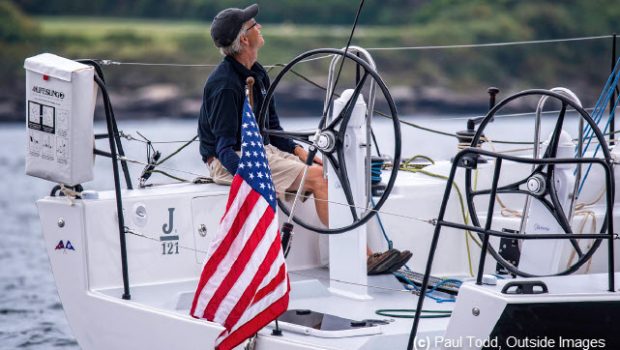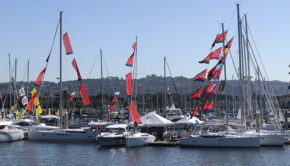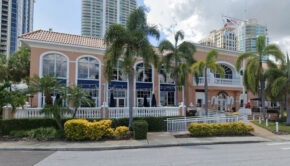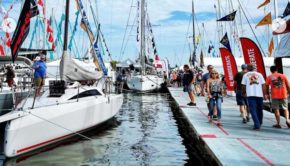Maintaining an Iconic Brand
Published on September 6th, 2018
If you’ve been on the water, sailing in the last 40 years, chances are you’ve crossed tacks with a modern J/Boat. Jeff Johnstone, President of J/Boats Inc, shares insight with Sail America, the trade association for the US sailing industry.
How many different boats is J/Boats now building?
We have eight active models that are sold through our international dealer network including a One-Design/Sport range (J/70, J/80, J/88, J/111, J/121) and a Performance Cruise/Race range (J/97E, J/112E, J/122E). The J/22 and J/24 are also still in limited production.
How do you decide what’s next?
Ah, the magic question. We have an ongoing new product plan that’s constantly changing based on our current line-up, what’s happening in the market, and what trends we’re expecting. When it comes to deciding what’s next, we home in on a specific need in the market and look at a new way to fulfill that need that we don’t already offer.
Every new design has to have its own reason for existing and has to be a step forward from what we’ve done before. We’re fortunate to have a knowledgeable base of J/sailors who are both our most passionate advocates and our biggest critics. Every new design has to meet or exceed their high expectations.
In the boating world, it seems like there are a lot of family-run businesses. Your board even has six cousins on it. How have you all navigated some of the challenges presented by this? Any advice for others?
The advantages of a family business, at least in my experience, far outweigh the challenges. The most obvious plusses are the shared passion, loyalty, trust, and the natural transfer of knowledge to the next generation at an early age.
My dad Rod and uncle Bob started J/Boats as a second career. Before we were working together, we were sailing together. And there’s no better way to prepare and/or test a team’s ability to work together than to go sailboat racing together.
The biggest challenge for most family businesses is passing the company reins from Gen [generation] 1 to Gen 2. We were lucky in that Rod and Bob left the door open early on for us to get involved, and one by one we migrated from other jobs to J/Boats as opportunities came up.
By our late 20s in 1988, we were managing day-to-day operations as well as the board of directors. It was a huge leap of faith on Gen 1’s part, but it also made us work that much harder. The founders stayed active with design and marketing, while we managed the key relationships (with builders, dealers, clients) that were essential for running the business.
The next transition phase was the transfer of knowledge (design and marketing) that had really started years earlier, but then continued to develop organically each year until the point where Gen 2 was self-sufficient in these core skill areas.
The third part of the generational transition was ownership transfer. This came much easier once the management and skills transfer had taken place. But it all started with the willingness of the founders to step back enough to allow the next gen to sink or swim.
J/Boats were first manufactured in Rhode Island; but now you have licensed builders in Argentina, Italy, France and China. What were some of the deciding factors and challenges with this expansion? Anything you’d do differently in hindsight?
Following its introduction, the J/24 was in such demand worldwide that by 1981 there were builders in Australia, Italy, England, Argentina, and both coasts of the USA – all utilizing molds that were originally used in Rhode Island during the height of J/24 output of five to six boats per day.
The main reason for licensing manufacturing overseas is to be more competitive in those markets. It’s otherwise an uphill battle to develop critical mass via exporting alone. We follow the same principle today. If there’s sufficient interest on a particular continent for one of our new designs, we’ll look into options to build the model there.
There are 150-plus J/80s sailing in China right now thanks to having a builder in that market. In fact, 95 percent of the J/80s built in China have stayed in China. We most recently shipped a set of J/70 molds to Buenos Aires, Argentina to better serve the South American market, which already has 50-plus J/70s there.
Last summer, J/Boats sponsored and organized a new event — the J/70 Youth Champs in Newport. Can you tell us more about the event and the philosophy behind it?
We’ve seen firsthand how an early introduction to keelboat sailing can help create lifelong sailors. The J/70 is a great all-ages platform, so it seemed natural to encourage a new generation of keelboat sailors with a new event.
Bob and Stu Johnstone conceived the event and got things going. The J/70 class owners, and sponsors like Sail22, loaned boats for youth teams to qualify, and Sail Newport hosted the first event.
This year, St. Petersburg Yacht Club has taken over, and the finals will take place in November. (Up to 13 teams will qualify by being the top youth team at one of the NOOD regattas or selected race weeks. (details)
What is one of your favorite philosophical phrases?
90 percent of life is showing up.
If you could go sailing with anyone (dead or alive), who would it be, where and why?
Again, so many possibilities. But I’d have to pick Francois Gabart, who sailed (in 2017) solo, nonstop, around the world in an unbelievable 42 days (breaking the previous record by seven days). A sail with Francois on his 100-foot trimaran, screaming along the Brittany coast, would be a ride to remember.










 We’ll keep your information safe.
We’ll keep your information safe.